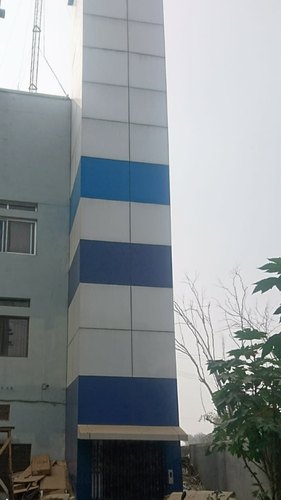Goods Elevator Manufacturer
Our Product Range Includes a Wide Range Of Goods Elevator, Hydraulic Goods Elevator, Usha Goods Elevator, Usha External Goods Elevator, Usha Wall Mounted Elevator, Usha Long Platformed Goods Elevator, Usha Hydraulic Home Elevator and Height Rails Goods Elevator.
What is Goods Elevators?
A goods elevator, also known as a freight elevator or service elevator, is a type of elevator that is designed to transport goods and materials, rather than people. They are typically larger and more heavy-duty than passenger elevators, and are often used in commercial and industrial buildings, warehouses, and other facilities where goods need to be moved between different levels. Goods elevators can have manual or automatic doors, and may be operated by a control panel or a key switch. Some goods elevators are also equipped with special features such as ramps or platform lifts for loading and unloading cargo.
| Capacity | 1-2 ton |
| Brand | Usha |
| Usage/Application | Inndustrial |
| Model Name/Number | LEI02 |
| Structure | Mild Steel |
| Material | Stainless Steel |
Outer Goods Elevator
Complete Coverage with Color Coated Sheet/MS Wire Mess Cage, etc.
Load Bearing Capacity Up to 5.0 Ton.
Working height Up to 20.0 Mtr.

FREQUENTLY ASKED QUESTION
The capacity of goods elevators typically ranges from 500 kg (1100 lbs) to 10,000 kg (22,000 lbs) or more. Some larger cargo elevators are capable of carrying loads of up to 50,000 kg (110,000 lbs) or more. The actual capacity of a goods elevator is usually specified by the elevator manufacturer and is based on factors such as the size and strength of the car, the power of the motor, and the capacity of the suspension system.
It is important to ensure that the weight of the goods being transported does not exceed the maximum capacity of the elevator, as this can cause the elevator to malfunction or become unsafe. Building codes and regulations typically require that the capacity of the elevator be clearly marked, and that the elevator is regularly inspected and maintained to ensure its safe operation.
In aviation, there are four main types of lift:
Aerodynamic lift: This is the most common type of lift and is generated by the wings of an aircraft. As the wings move through the air, they create a pressure difference, with lower pressure on top and higher pressure on the bottom of the wing, which generates a lifting force.
Engine lift: This type of lift is generated by the thrust of the aircraft’s engines. It is typically used during takeoff and initial climb, where the aircraft needs additional lift to become airborne.
Ground effect lift: This is a phenomenon that occurs when an aircraft is flying close to the ground. The ground reduces the amount of downwash behind the wing, which in turn increases the lift generated by the wing.
Thermal lift: This type of lift is generated by rising columns of warm air, known as thermals. Glider pilots often use thermal lift to gain altitude without the need for an engine.
The type of elevator that is best depends on various factors, including the building’s size, the number of floors, the amount of foot traffic, and the specific needs of the building and its occupants.
Here are some types of elevators commonly used in different settings:
Hydraulic elevators: These are good for low-rise buildings (up to six stories) and are typically slower and less energy-efficient than other types. They use a hydraulic fluid to move the elevator car.
Traction elevators: These are better suited for high-rise buildings and are typically faster and more energy-efficient than hydraulic elevators. They use steel ropes and counterweights to move the elevator car.
Machine-room-less elevators: These are space-saving options that do not require a separate machine room. They can be hydraulic or traction and are typically used in mid-rise buildings (up to 10 stories).
Destination dispatch elevators: These use advanced computer systems to optimize elevator efficiency and reduce wait times. They are ideal for buildings with high foot traffic and multiple destinations.
Dumbwaiters: These are small elevators used to transport goods or food between floors, and are typically found in restaurants, hotels, and hospitals.
Ultimately, the best type of elevator for a building will depend on a range of factors, including the building’s height, the amount of foot traffic, the available space, and the specific needs of the building and its occupants. A qualified elevator professional can help determine the most suitable type of elevator for a particular building.
In general, there are two main types of lifts, which are hydraulic lifts and traction lifts.
Hydraulic lifts: These lifts use a hydraulic piston to move the elevator car. They are typically used in low-rise buildings and have a maximum travel distance of about six floors. Hydraulic lifts are slower and less energy-efficient than traction lifts but are usually more cost-effective for smaller buildings.
Traction lifts: These lifts use a motor and a system of ropes and pulleys to move the elevator car. They are typically used in mid-rise and high-rise buildings and can travel up to 50 or more floors. Traction lifts are faster and more energy-efficient than hydraulic lifts but require a dedicated machine room to house the motor and control system.
There are also various other types of lifts, such as dumbwaiters, which are small lifts used to transport goods or food between floors, and scenic lifts, which are designed to provide passengers with a panoramic view during their journey. However, hydraulic and traction lifts are the two main types of lifts used in most buildings for passenger transportation.
